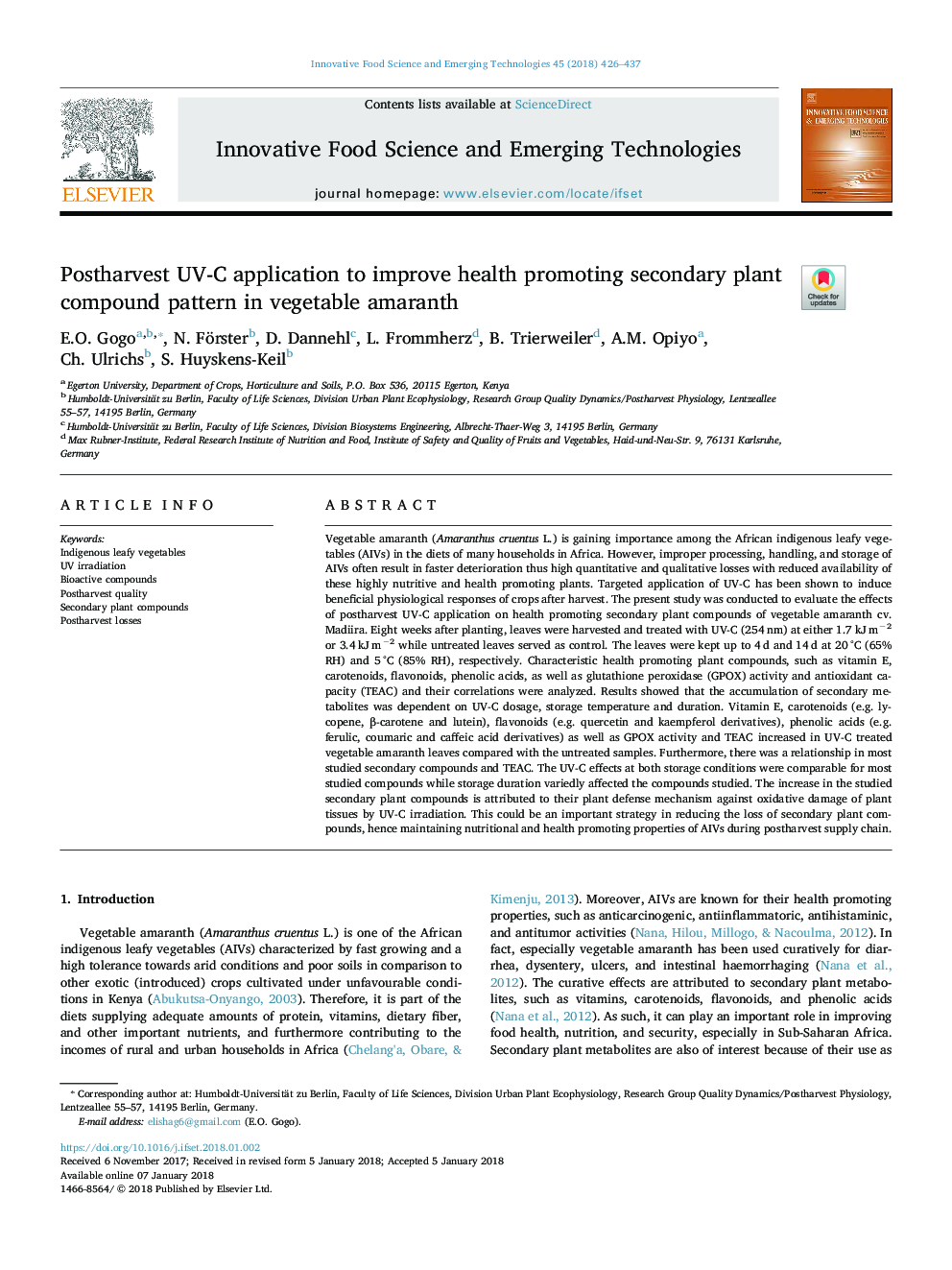| کد مقاله | کد نشریه | سال انتشار | مقاله انگلیسی | نسخه تمام متن |
|---|---|---|---|---|
| 8415697 | 1545523 | 2018 | 12 صفحه PDF | دانلود رایگان |
عنوان انگلیسی مقاله ISI
Postharvest UV-C application to improve health promoting secondary plant compound pattern in vegetable amaranth
دانلود مقاله + سفارش ترجمه
دانلود مقاله ISI انگلیسی
رایگان برای ایرانیان
کلمات کلیدی
موضوعات مرتبط
علوم زیستی و بیوفناوری
علوم کشاورزی و بیولوژیک
دانش تغذیه
پیش نمایش صفحه اول مقاله

چکیده انگلیسی
Vegetable amaranth (Amaranthus cruentus L.) is gaining importance among the African indigenous leafy vegetables (AIVs) in the diets of many households in Africa. However, improper processing, handling, and storage of AIVs often result in faster deterioration thus high quantitative and qualitative losses with reduced availability of these highly nutritive and health promoting plants. Targeted application of UV-C has been shown to induce beneficial physiological responses of crops after harvest. The present study was conducted to evaluate the effects of postharvest UV-C application on health promoting secondary plant compounds of vegetable amaranth cv. Madiira. Eight weeks after planting, leaves were harvested and treated with UV-C (254â¯nm) at either 1.7â¯kJâ¯mâ2 or 3.4â¯kJâ¯mâ2 while untreated leaves served as control. The leaves were kept up to 4â¯d and 14â¯d at 20â¯Â°C (65% RH) and 5â¯Â°C (85% RH), respectively. Characteristic health promoting plant compounds, such as vitamin E, carotenoids, flavonoids, phenolic acids, as well as glutathione peroxidase (GPOX) activity and antioxidant capacity (TEAC) and their correlations were analyzed. Results showed that the accumulation of secondary metabolites was dependent on UV-C dosage, storage temperature and duration. Vitamin E, carotenoids (e.g. lycopene, β-carotene and lutein), flavonoids (e.g. quercetin and kaempferol derivatives), phenolic acids (e.g. ferulic, coumaric and caffeic acid derivatives) as well as GPOX activity and TEAC increased in UV-C treated vegetable amaranth leaves compared with the untreated samples. Furthermore, there was a relationship in most studied secondary compounds and TEAC. The UV-C effects at both storage conditions were comparable for most studied compounds while storage duration variedly affected the compounds studied. The increase in the studied secondary plant compounds is attributed to their plant defense mechanism against oxidative damage of plant tissues by UV-C irradiation. This could be an important strategy in reducing the loss of secondary plant compounds, hence maintaining nutritional and health promoting properties of AIVs during postharvest supply chain.
ناشر
Database: Elsevier - ScienceDirect (ساینس دایرکت)
Journal: Innovative Food Science & Emerging Technologies - Volume 45, February 2018, Pages 426-437
Journal: Innovative Food Science & Emerging Technologies - Volume 45, February 2018, Pages 426-437
نویسندگان
E.O. Gogo, N. Förster, D. Dannehl, L. Frommherz, B. Trierweiler, A.M. Opiyo, Ch. Ulrichs, S. Huyskens-Keil,